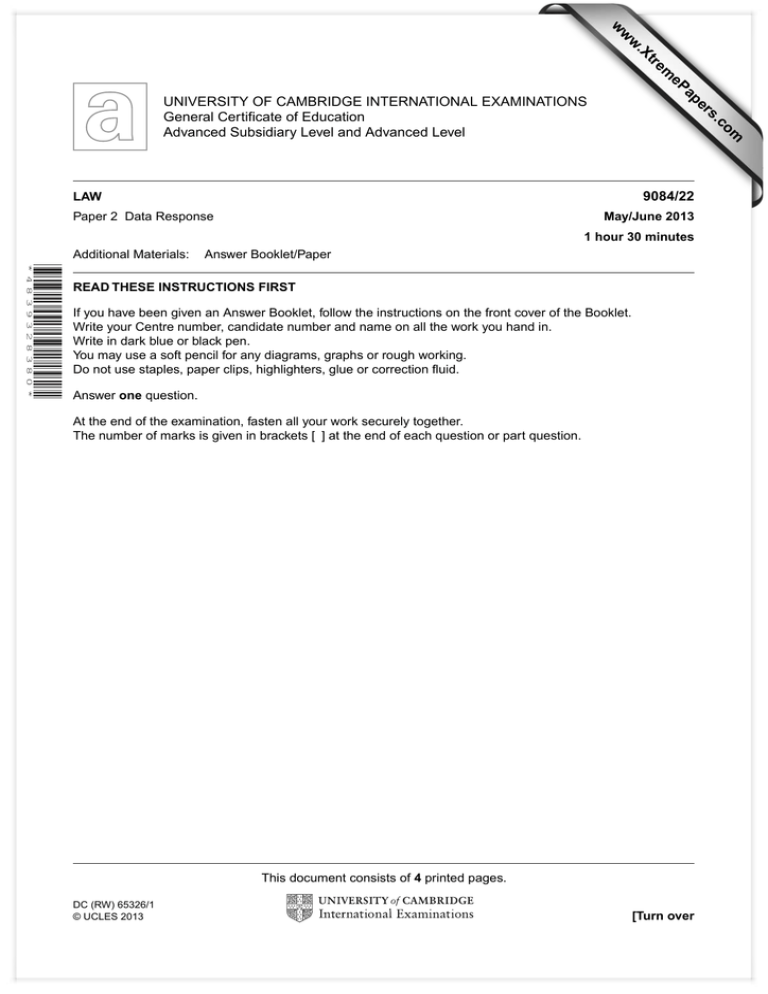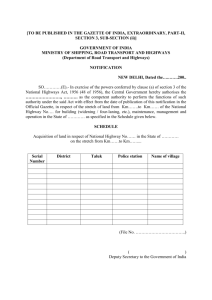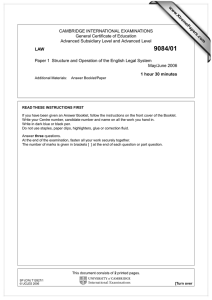www.XtremePapers.com
advertisement

w w ap eP m e tr .X w om .c s er UNIVERSITY OF CAMBRIDGE INTERNATIONAL EXAMINATIONS General Certificate of Education Advanced Subsidiary Level and Advanced Level 9084/22 LAW Paper 2 Data Response May/June 2013 1 hour 30 minutes Additional Materials: Answer Booklet/Paper * 4 8 3 9 3 2 8 3 8 0 * READ THESE INSTRUCTIONS FIRST If you have been given an Answer Booklet, follow the instructions on the front cover of the Booklet. Write your Centre number, candidate number and name on all the work you hand in. Write in dark blue or black pen. You may use a soft pencil for any diagrams, graphs or rough working. Do not use staples, paper clips, highlighters, glue or correction fluid. Answer one question. At the end of the examination, fasten all your work securely together. The number of marks is given in brackets [ ] at the end of each question or part question. This document consists of 4 printed pages. DC (RW) 65326/1 © UCLES 2013 [Turn over 2 Answer either Question 1 or Question 2. You should make appropriate reference to the source material supplied for each question. 1 One cold and frosty day in early January Pippa leaves her new home and drives to her local shopping centre. There is ice on the road but the highways authority has taken no action to deal with this. At the shopping centre Pippa purchases a set of glasses, some plates and two cushions. She is not familiar with the road and on the way home she drives round a sharp corner and the car skids on some ice hitting a lamp post at the side of the road. All the glasses and china are broken. The cushions cannot be used as they both have pieces of glass and china embedded in them. Pippa is injured and taken to hospital with a broken leg. She cannot work for 4 weeks and loses £1500 in earnings. The cost of the goods damaged is £300 and the repairs to her car cost £1200. (a) Advise Pippa whether she has a claim against the highways authority on the grounds that the corner in the road was not properly signposted. [10] (b) Advise Pippa whether she has a claim against the highways authority on the grounds that it has not discharged its duty to ensure that the road is free from ice. [10] The same day Pippa’s mother Freda decides to walk to the shops. She is walking along and trips on an uneven flagstone. She falls and breaks her ankle. She brings a claim against the highways authority for failing to repair the highway. She has photographs showing a gap between the flagstones which is about 10 cm deep. The highways authority produces records showing that this area is inspected once a month. No defects were seen prior to the accident. (c) Advise Freda whether she is likely to succeed in her claim against the highways authority. [10] (d) Consider the difficulties that face a court when trying to apply legislation. What are the various intrinsic and extrinsic aids that it has at its disposal to assist with the interpretation of statutes? [20] © UCLES 2013 9084/22/M/J/13 3 Source Material Highways Act 1980 s.41 Duty to maintain highways maintainable at public expense. (1) The authority who are for the time being the highway authority for a highway maintainable at the public expense are under a duty...to maintain the highway. (1A) In particular, a highway authority are under a duty to ensure, so far as is reasonably practicable, that safe passage along a highway is not endangered by snow or ice. Highways Act 1980 s.58 Special defence in action against a highway authority for damages for non-repair of highway. (1) In any action against the highway authority in respect of damage arising from their failure to maintain a highway maintainable at the public expense it is a defence…to prove that the authority had taken such care as in all the circumstances was reasonably required to secure that the part of the highway to which the action relates was not dangerous for traffic. (2) For the purposes of a defence under subsection (1) above, the court shall in particular have regard to the following matters: (a) the character of the highway, and the traffic which was reasonably to be expected to use it; (b) the standard of maintenance appropriate for a highway of that character and used by such traffic; (c) the state of repair in which a reasonable person would have expected to find the highway… Littler v Liverpool Corporation [1968] ‘…It is a mistake to isolate and emphasise a particular difference in levels between flagstones unless that difference is such that a reasonable person who noticed and considered it would regard it as presenting some real danger…’ Cumming-Bruce J Gorringe v Calderdale MBC [2004] A highway authority’s failure to place a marking or to install a road sign warning motorists that they were approaching a dangerous part of the road did not constitute a breach of its duty under the Highways Act 1980 s.41. © UCLES 2013 9084/22/M/J/13 [Turn over 4 2 Andy and Ceri are two burglars who work together as a team. Andy was born in 1996 and Ceri was born in 1991. In July 2010 they were convicted of breaking into a mobile home on the driveway of a house. The offence took place in 2009. In August 2011 they were convicted of breaking into a garage of a private house. This offence took place in 2010. In December 2012 they broke into a flat (apartment). The flat was unoccupied and being renovated. They are now charged with burglary and both appear on indictment at the Crown Court. (a) Explain with reasons whether the provisions of s.111(1)(a) and (b) Powers of Criminal Courts and Sentencing Act 2000 will apply to each of the defendants. [10] (b) Explain with reasons whether the provisions of s.111(1)(c) Powers of Criminal Courts and Sentencing Act 2000 will apply to each of the defendants. [10] (c) What interpretation issues arise as a consequence of the application of s.5 Powers of Criminal Courts and Sentencing Act 2000? [10] (d) Consider the appropriate sentences that each of the two offenders could expect to receive from the Crown Court if convicted of the latest burglary. What matters may influence the court in deciding the sentences? [20] Source Material Powers of Criminal Courts and Sentencing Act 2000 s.111 (1) This section applies where – (a) a person is convicted of a domestic burglary committed after 30th November 1999; (b) at the time when that burglary was committed, he was 18 or over and had been convicted in England and Wales of two other domestic burglaries; and (c) one or other of these burglaries is committed after he had been convicted of the other and both were committed after 30th November 1999. (2) The court shall impose an appropriate sentence of imprisonment of a term of at least 3 years except where the court is of the opinion there are particular circumstances which – (a) relate to any of the offences or to the offender; and (b) would make it unjust to do so in all the circumstances. (5) In this section ‘domestic burglary’ means a burglary committed in respect of a building or part of a building which is a dwelling. Permission to reproduce items where third-party owned material protected by copyright is included has been sought and cleared where possible. Every reasonable effort has been made by the publisher (UCLES) to trace copyright holders, but if any items requiring clearance have unwittingly been included, the publisher will be pleased to make amends at the earliest possible opportunity. University of Cambridge International Examinations is part of the Cambridge Assessment Group. Cambridge Assessment is the brand name of University of Cambridge Local Examinations Syndicate (UCLES), which is itself a department of the University of Cambridge. © UCLES 2013 9084/22/M/J/13





